Charlottesville Reopens The Debate Over Confederate Symbols
It's time to stop honoring the symbols of a nation of racist traitors.
Inevitably, the events of this past weekend in Charlottesville have reopened the debate over memorials to Confederate Generals and other officials in public places and the proper way that this part of American history should be memorialized and discussed. In a way, of course, this is a debate that never really went away since this has been a contentious issue for quite some time now. Most recently, though, it was brought into the public consciousness by the senseless murder of nine people in a historically African-American church in Charleston, South Carolina by a man with clearly racist motivations. That event led to a debate over the Confederate Battle Flag that was still flying on the grounds of the South Carolina Capitol Building in Columbia, something that finally came to an end in the wake of the Charleston murders. In the days as weeks that followed, similar debates sprang up elsewhere in the country and led to the removal of Confederate symbols from public places in Alabama and other states as well as decisions by private retailers to remove merchandise depicting the Confederate Battle Flag from their shelves. The debate also spread to other symbols of the Confederacy spread all over the South and even in national parks such as the Gettysburg Battlefield in Pennsylvania. Most recently, that debate has seen events such as the removal of statutes to Confederate Generals in New Orleans, Lousiana as well as debates over the issue across the country, including in Charlottesville where the statue of Robert E. Lee became the gathering point for the Neo-Nazi and alt-right groups that came to that city in Central Virginia from all over the country.
Writing about the issue at National Review, Rich Lowry, who serves as the editor, argues that it’s time for the Confederate monuments to be taken down:
The monuments should go. Some of them simply should be trashed; others transmitted to museums, battlefields, and cemeteries. The heroism and losses of Confederate soldiers should be commemorated, but not in everyday public spaces where the monuments are flashpoints in poisonous racial contention, with white nationalists often mustering in their defense.
Some discrimination is in order. There’s no reason to honor Jefferson Davis, the blessedly incompetent president of the Confederacy. New Orleans just sent a statue of him to storage — good riddance. Amazingly enough, Baltimore has a statue of Chief Justice Roger Taney, the author of the monstrous Dred Scott decision, which helped precipitate the war. A city commission has, rightly, recommended its destruction.
(…)
For supporters of the Confederate monuments, removing them from parks and avenues will be a blow against their heritage and historical memory. But the statues have often been part of an effort to whitewash the Confederacy. And it’s one thing for a statue to be merely a resting place for pigeons; it’s another for it to be a fighting cause for neo-Nazis. Lee himself opposed building Confederate monuments in the immediate aftermath of the war. “I think it wiser,” he said, “not to keep open the sores of war, but to follow the examples of those nations who endeavoured to obliterate the marks of civil strife and to commit to oblivion the feelings it engendered.” After Charlottesville, it’s time to revisit his advice.
In a similar vein Ramesh Ponnuru, who is also a senior editor at National Review, writes at Bloomberg that it’s time to bury the Confederacy for good:
They may call themselves “white nationalists,” but the adjective nullifies the noun. In Charlottesville, Virginia, few of them hoisted American flags. They marched under banners the United States took up arms to fight. Their stated cause was preserving a statue of a man who committed treason against our country: Robert E. Lee.
Confederate flags, statuary and memorials have defenders who wish to have nothing to do with neo-Nazis or white supremacists. They say that they mean to honor the valor of Confederate soldiers rather than the cause for which they bled. Or they say that we should have visible and uncensored reminders of our history. If Lee statues go, they ask, will Monticello be next? Mount Vernon?
(…)
Those who defend Lee statues and worse often say they are motivated by “heritage not hate.” There is no reason to doubt them. But the meaning of a public symbol is not a private possession. They may tell themselves that the statue should stay to honor Lee’s (allegedly) conciliatory behavior after the war. Can they really tell black people who interpret it differently — who look at that statue, erected in the same period as “The Birth of a Nation” and the second Ku Klux Klan, and see a public display of contempt for their dignity and rights — that their reaction is absurd? The marching racists were vile and stupid. But they weren’t crazy to treat the statue as a vestige of white supremacy.
There are, as always, prudential considerations. Removing memorials will cost city governments money. The Charlottesville experience could be read either to suggest that Confederate statues must be taken down to keep white supremacists from having a rallying point, or that trying to take them down gives them one.
But our deliberations should not dwell too long on these cretins. The South has and deserves its pride, but it ought not center it on the most shameful moment in its history. The statues and the flags should come down. They will come down, as Southerners of all races come to see that this cause, too, is better off lost.
Lowry and Ponnuru are, of course, on the correct side of this argument. There is quite simply no good reason why the symbols of the Confederacy, which was defeated in battle more than 150 years ago, should continue to exist in places of honor or respect anywhere in the United States. While they may represent people or events that occurred in the past, they do so largely without any context with regard to their meaning or what the Confederacy and the men who created it actually stood for. Instead, they send a message to the public, and most especially to members of minority groups, that the truth of that history should be forgotten and the men who represented it are deserving of honor and respect rather than the contempt that history should justly have for them. Additionally, these spots not only provide a gathering spot for the haters and bigots who flocked around the statue of General Lee this past weekend, they also do exactly what the opponents of their removal claim we shouldn’t be doing, whitewashing history.
Those who have an alternate view of history will claim that secession and the Civil War were about something other than slavery, or at least not primarily about slavery. Instead, they claim that other issues such as tariff policy, the economy, political power in Washington, which was slowly shifting away from the South notwithstanding its power in the Senate, and the debate over so-called “states rights.” While it’s true that these issues played some role in the relationship between the North and South in the ante bellum years, it was clearly the debate over slavery and its expansion into the western territories that drove the dynamic of that relationship, and it was the desire to protect that “peculiar institution” that led to the creation of the Confederacy. American political history from the founding until the firing of the first shots at Fort Sumter is full of that history, including the Fugitive Slave Act, the Compromise of 1820, the Missouri Compromise, the battles over Kansas between forces for and against slavery, John Brown’s raid on Harper’s Ferry, and the Election of 1860 itself. It’s worth noting, though, that the secession of South Carolina and the states of the Deep South was not prompted by any overt act by the United States, but by the fact that Abraham Lincoln, who wasn’t even necessarily an abolitionist himself, was elected President. The fact that Lincoln could not have done much of anything to threaten slavery in the South thanks to the fact that Congress, and especially the Senate, was firmly in the control of Southern politicians, was seemingly not sufficient for the group of elitists and pro-slavery radicals who pushed the secession movement. What did push the movement, though, was slavery and racism. One need only read the Secession Resolutions themselves, or the words of the man who became the Vice-President of the Confederacy, Alexander Stephens: (emphasis mine)
The new constitution has put at rest, forever, all the agitating questions relating to our peculiar institution African slavery as it exists amongst us the proper status of the negro in our form of civilization. This was the immediate cause of the late rupture and present revolution. Jefferson in his forecast, had anticipated this, as the “rock upon which the old Union would split.” He was right. What was conjecture with him, is now a realized fact. But whether he fully comprehended the great truth upon which that rock stood and stands, may be doubted. The prevailing ideas entertained by him and most of the leading statesmen at the time of the formation of the old constitution, were that the enslavement of the African was in violation of the laws of nature; that it was wrong in principle, socially, morally, and politically. It was an evil they knew not well how to deal with, but the general opinion of the men of that day was that, somehow or other in the order of Providence, the institution would be evanescent and pass away. This idea, though not incorporated in the constitution, was the prevailing idea at that time. The constitution, it is true, secured every essential guarantee to the institution while it should last, and hence no argument can be justly urged against the constitutional guarantees thus secured, because of the common sentiment of the day. Those ideas, however, were fundamentally wrong. They rested upon the assumption of the equality of races. This was an error. It was a sandy foundation, and the government built upon it fell when the “storm came and the wind blew.”
Our new government is founded upon exactly the opposite idea; its foundations are laid, its corner- stone rests, upon the great truth that the negro is not equal to the white man; that slavery subordination to the superior race is his natural and normal condition. This, our new government, is the first, in the history of the world, based upon this great physical, philosophical, and moral truth. This truth has been slow in the process of its development, like all other truths in the various departments of science. It has been so even amongst us. Many who hear me, perhaps, can recollect well, that this truth was not generally admitted, even within their day. The errors of the past generation still clung to many as late as twenty years ago. Those at the North, who still cling to these errors, with a zeal above knowledge, we justly denominate fanatics. All fanaticism springs from an aberration of the mind from a defect in reasoning. It is a species of insanity. One of the most striking characteristics of insanity, in many instances, is forming correct conclusions from fancied or erroneous premises; so with the anti-slavery fanatics. Their conclusions are right if their premises were. They assume that the negro is equal, and hence conclude that he is entitled to equal privileges and rights with the white man. If their premises were correct, their conclusions would be logical and just but their premise being wrong, their whole argument fails. I recollect once of having heard a gentleman from one of the northern States, of great power and ability, announce in the House of Representatives, with imposing effect, that we of the South would be compelled, ultimately, to yield upon this subject of slavery, that it was as impossible to war successfully against a principle in politics, as it was in physics or mechanics. That the principle would ultimately prevail. That we, in maintaining slavery as it exists with us, were warring against a principle, a principle founded in nature, the principle of the equality of men. The reply I made to him was, that upon his own grounds, we should, ultimately, succeed, and that he and his associates, in this crusade against our institutions, would ultimately fail. The truth announced, that it was as impossible to war successfully against a principle in politics as it was in physics and mechanics, I admitted; but told him that it was he, and those acting with him, who were warring against a principle. They were attempting to make things equal which the Creator had made unequal.
The historical record is clear as to what the Confederacy was, and to display their banners or commemorate their leaders and Generals in anything other than a historical context is to give an implicit endorsement to those doctrines the same as if one were to file a Nazi Flag from their window.
Monuments, especially monuments in public places such as town squares and the like, are not history. They are celebration, adulation, and they send a message that the person or subject matter portrayed in the monument is worthy of esteem or celebration. There are no statutes to George III or General Cornwallis in public places in the United States because these were people who the united colonies fought against to assert, protect, and defend the independence of American colonists from Great Britain. Similarly, one does not see the Britsh erecting statues of George Washington or Thomas Jefferson, because those men were adversaries who rebelled from what was their home country to form a new nation and no monuments to anyone involved in the War of 1812 on the American side in Canada, for the same reason. Similarly, there is no reason for people who fought for a nation built on the twin evils racism and slavery in the United States, not even in the part of the country where they originated from. Instead, these monuments or their equivalents should be put in museums or other locations where they can be placed in the proper historical context. For those who might object, this would include places such as the countless number of battlefields across the South and in places such as Antietam in Maryland and Gettysburg in Pennsylvania. In these places, the monuments can be placed in appropriate context, as can the history of the Confederacy itself. To treat them in any other way is to whitewash history and try to persuade people to forget the evil that it represented.
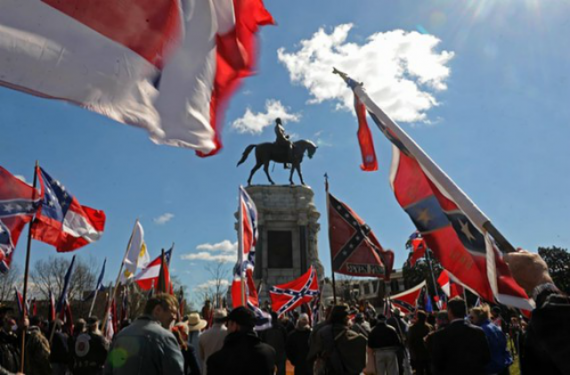

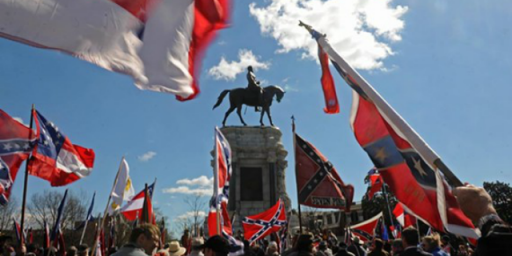
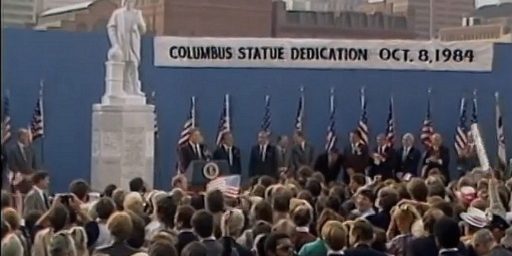
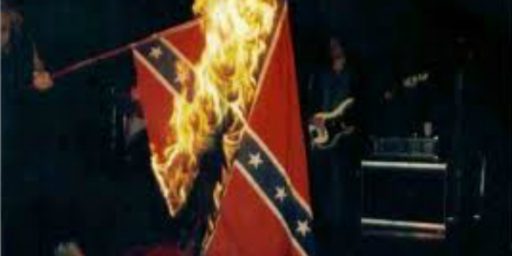
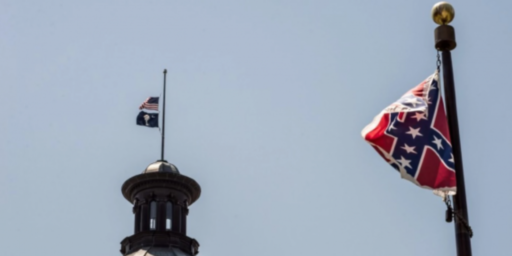
Growing up in the South, I was sympathetic to the idea that the Civil War wasn’t about slavery, that monuments were about heritage not hate, etc. That began to break in high school and really came apart in my 20’s as I read more about what the secessionists themselves said the war was all about and how/when/why those monuments were built.
This is the argument that ultimately persuaded me. State flags, official buildings, statues in public places, etc., are supposed to represent all all the people. Black people are part of the people. And if you have a symbol or a statue that offends such a huge fraction of the people, you need to get rid of it and replace it with something that all the people can be proud of.
You’re doing some fine work, Doug.
I’ve lived around them for 40 years. If you buy that Heritage Not Hate shit, you’re a sucker.
Expect the Deplorables to throw a fit. There are reports this afternoon about vandalism at the lincoln memorial.
@teve tory: I think what happened in Charlottesville on Saturday is ample proof Ponnuru is full of shit.
That started out as a defense of a Lee statue, after all.
Damn it, I really liked Dukes of Hazzard when I was a kid. But I’m grown up now. It’s a pity more don’t know the true story of that bit of “heritage”.
If there was one guy to hang after the war, it would have been Nathan Bedford Forrest for his numerous war crimes. Regardless, he survived. But not only did he survive, but this man who was happy to massacre troops went on to form the KKK, which became the terrorist backbone of the post-reconstruction South.
Lee was what white Southerners in their pathetic stupidity wanted to believe they were like, but Forrest was who they were if they thought about the South. Tear every one of them down.
Fine piece, Doug. I was going to comment that I’ve never seen a statue of General Cornwallis outside the Massachusetts state house, nor do I see the Union Jack flying over its golden dome, but you pretty much beat me to it.
Those monuments and the rebel battle flags that one sees fairly often (at least here in the south) are not memorials of the War of 1861-65. They are celebrations of the victories won by the governing class in the south when they won the War of Reconstruction.
@teve tory:
I never realized until I was well into adulthood how profound the hatred for Lincoln still is in the south.
I’m nowhere near a TV, but given my Twitter feed, the President just gave another amazingly bad press conference, in which he appears to have retreated to the “both sides” argument blaming some of the violence on the “alt-left” (WTF?), and, to cap it off, Maggie Haberman tweeted out this gem.
Trump really cannot handle this job. Seriously bad combo of the Peter Principle and Dunning-Kruger.
Today General Lee and other southern generals.
Tomorrow Washington, Jefferson, Polk, Grant, Sheridan, Burnside, Pershing, Patton, McArthur, Halsey.
Also don’t forget that a lot of those statues were put up in the 1920s and 1930s, when Jim Crow was coming back.
None of those statues were for glory. They were for “keeping the Negro in his place.”
(And I’d almost rather they KEEP the bloody Taney statue where it is, but put a big fat plaque in front of it outlining exactly how his SCOTUS decision helped bring on the Civil War and how much of a contemptible person he was.)
@Jen:
Oh, dear God. I just read Haberman’s tweet. Can’t this s.o.b. be muzzled?
@CSK:
What we wish for and what we get are not always the same things. Apparently David Duke has praised the President’s press conference today for drawing attention to the “violence of the alt-left.” Trump said there are “good people” on “both sides.”
Honestly, he is truly a global embarrassment.
@Tyrell: You poor dumb cracker. Are you transforming your performance art to “Tyrell: Sufferer of Dementia?”
@Tyrell: You left out my favorite southern born Civil War USA general, George Thomas. I also have a soft spot in my heart for Braxton Bragg, who, despite serving in the CSA, was responsible for a number of Union victories.
Washington, Jefferson (Barbary pirates), Polk, Grant, Sheridan, Burnside, Pershing, Patton, McArthur, Halsey, and Thomas.
Lee.
Somehow I feel there’s a significant difference between those two lists.
@Jen:
I’ve been hearing the term “alt-left” for several months now. I have two points to make:
1) This whole “I know you are but what am I?” tactic is premised on the assumption that the term “alt right” was some slur invented by the left to disparage right-wingers. In fact the term came from members of the alt-right movement themselves, specifically Richard Spencer, the white nationalist credited with coining the term. It is Trump’s own Steve Bannon who ran a website that he proudly described as a “platform for the alt right.” If anything we’re being excessively kind to the movement by describing them by their own, self-chosen term instead of calling them what they actually are: white supremacists.
2) Note that the term “alt left” is being applied here to any protester who came out to oppose the white nationalists. That’s so absurdly broad an application as to render the term utterly meaningless.
@gVOR08: My favorite was Burnside. Sheridan was in so many battles. Sherman helped parts of the south rebuild. There are remains an old mill in Columbia, SC near the zoo that Sherman tore up during his march through the south. Many people make the walk down there when they visit the zoo.
The flags and banners of the Confederate States of America are not the symbols of my country: The United States of America. They represent some other country.
There should be no confusion about what these alien flags represent.
I am certain that people who claim those foreign pennants as their own will be glad to carry a Green Card and display it to United States officals on demand!
“Heritage not Hate”. I think I’m going to puke.
@teve tory: And the Holocaust Memorial in Boston.
@Mister Bluster: Especially if you read Taney’s “originalist” analysis in the Dred Scott decision.
(Ironically enough, it turns out that Scott was freed after the decision and unfortunately died of pneumonia soon after. It was the SCOTUS decision which was so terrible.)
The United States of America won the war.
Appomattox
If you want to fly a flag to show your southern heritage, shouldn’t you fly the state flag of the southern state you call home? They know why they fly it, wear it on t-shirts, all that BS…the ignorance is astounding. They don’t know and they don’t care. How can you rationalize with that? I cant , veins pop in my head and I don’t need the stress, bless those who try, like Doug through his writing. If only sanity was contagious.
It seems that in the last four or five years I have notice a substantial increase in the display of these Confederate flags: trucks, yard poles, windows, caps, and shirts. I don’t know exactly what caused this increase. Until then, it had got to be very rare to see one.
The local shop that sells them can’t keep up with demand.
@Tyrell: Just guessing, you understand, but I suspect that the increase had something to do with both the race and party leanings of the previous President.
But it may just be coincidental.
@Tyrell:
It takes a while for the ship to arrive from China.
@Just ‘nutha ig’nint cracker: I have thought about that. Could be a connection. There is also the common reaction that takes place when the government or some group tries to ban something. It just increases the sales and use: books and movies are examples. I remember a few years NASCAR tried to discourage the display of the Confederate flag at the car races. It seemed to me that after that there are now twice as many. It probably would have been better if they had said nothing at all .
@Tyrell:..It probably would have been better if they had said nothing at all.
Good advice for the racist, pervert, Republican President Pork Chop Pud!
@Just ‘nutha ig’nint cracker:
I’m a math tutor in the deep south. Remember when Obama got elected and he gave a tv address to all the school kids to tell them to work hard and don’t do drugs etc? I had an elementary-grade little redneck kid whose mom kept him out of school that day so he wouldn’t have to hear Obama.